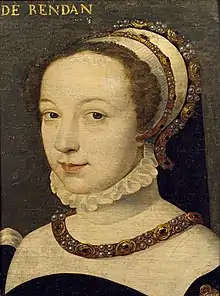Fulvie de Randan
Fulvie de Randan, née Pic de Mirandole (1533–1607) was a French court official. She served as Première dame d'honneur to the queen of France, Louise of Lorraine, from 1583 until 1601.


Life
Fulvie de Randan was the daughter of Galeotto II Pico della Mirandola (d.1551) and Hippolita di Gonzaga-Sabionetta. She married Charles de La Rochefoucauld, Comte de Randan (1520–1583) in 1555. Her husband was killed at Rouen in 1562. The couple had five children, among them François. Her sister Sylvie married her husband's brother François III de La Rochefoucauld, prince of Marcillac, count of Roucy and baron of Verteuil, in a double marriage of siblings.[2]
She was a fille d'honneur, maid of honour, to Catherine de' Medici.[3] In 1583, she was appointed to the office of Première dame d'honneur to the new queen of France, Louise of Lorraine. She was given the position at the request of the queen, who was attracted to her piety, but the king found her to be too austere for the royal court, and although he granted the queen's wish, she split the office in two and appointed the more fashionable Louise de Cipierre to share the office with her: when de Cipierre died just two years later, however, de Randan did not have to share the office anymore.[4] As Première dame d'honneur, she was responsible for the female courtiers, controlling the budget, purchases, annual account and staff list, daily routine and presentations to the queen.
Fulvie de Randan was described as a beauty and a Catholic fanatic, determined to live out her life in an eternal mourning period after she was widowed, and known for her support for the Catholic League during the French Wars of Religion.[5] In 1570, she was known to have supported a marriage between Margaret of Valois and Henry I, Duke of Guise.[6] She was outspoken about her support of the Catholic League, and demonstrated them both during the Catholic uprising in 1585 as well as during the conflict between the king and the Ligue in 1588.[7]
Brantôme described her:
- "She wore a veil habitually, never showing her hair; yet spite of careless head-dress and her neglect of appearances, her great beauty was none the less manifest. The late M. de Guise, late deceased, was used always to call her naught but the nun; for she was attired and put on like a religious. This he would say by way of jest and merriment with her; for he did admire and honour her greatly, seeing how well affectioned and attached she was to his service and all his house."[8]
References
- Lyon, Corneille de; France (1525), Charles de La Rochefoucauld, comte de Randan (1523-1562)., retrieved 2023-03-23
- Potter, David (2004). Foreign Intelligence and Information in Elizabethan England: Volume 25: Two English Treatises on the State of France, 1580-1584 (in French). Cambridge University Press. ISBN 978-0-521-84724-7.
- Fléchier, Esprit (1844). Mémoires de Fléchier sur les Grands-Jours tenus à Clermont en 1665, 1666. Publiés par B. Gonod (in French). Porquet.
- Jacqueline Boucher, Deux épouses et reines à la fin du XVIe siècle: Louise de Lorraine et ...
- Jacqueline Boucher, Deux épouses et reines à la fin du XVIe siècle: Louise de Lorraine et ...
- Jacqueline Boucher, Deux épouses et reines à la fin du XVIe siècle: Louise de Lorraine et ...
- Jacqueline Boucher, Deux épouses et reines à la fin du XVIe siècle: Louise de Lorraine et ...
- Brantôme, Pierre de Bourdeille, Lives of fair and gallant ladies
- Jacqueline Boucher, Deux épouses et reines à la fin du XVIe siècle: Louise de Lorraine et ...
- Brantôme, Pierre de Bourdeille, The book of the ladies (illustrious dames)
- Dictionnaire de la noblesse ... de France